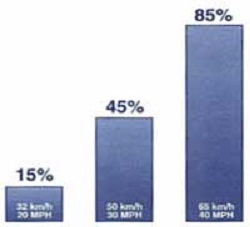Neighborhood Speed Watch Programs
Phoenix, Arizona
Prepared by Jeff Olson, R.A., Trailblazer. Information provided by Mike Cynecki, City of Phoenix.
Phoenix, Arizona
Prepared by Jeff Olson, R.A., Trailblazer. Information provided by Mike Cynecki, City of Phoenix.
Speeding on neighborhood streets and the resulting safety hazards for pedestrians were a concern for many Phoenix residents. Documenting the incidence of speeding was needed to increase education about the problem and to support future speed management measures such as traffic calming.

Pedestrian’s chances of death if hit by a motor vehicle. Source: Killing Speed and Saving Lives, UK Department of Transportation.
In many neighborhoods, the failure of motorists to obey posted speed limits is a major concern for pedestrian safety. The relationship between pedestrian injuries and fatalities and motor vehicle speeds has been well documented. The faster a motor vehicle is traveling when it hits a pedestrian, the greater the likelihood of a pedestrian fatality. The following chart from the United Kingdom Department of Transportation report "Killing Speed and Saving Lives" indicates this relationship.
Because speeding motorists and local pedestrians are often residents of the same neighborhood or adjacent communities, education and enforcement activities can be part of a local initiative for speed reduction. If motorist speeds can be kept within posted speed limits through these programs, the potential exists for improving pedestrian safety without capital construction. Several communities, including Kirkland, Washington; San Jose, California; and Phoenix, Arizona have developed local responses to this issue.
Neighborhood Speed Watch (NSW) programs provide residents with hand-held radar guns and ask them to record speeds, makes, models, and license plate numbers of vehicles that are speeding in the neighborhood. This can be done in conjunction with placing radar speed trailers in the field and as part of a broader community traffic safety campaign. Local law enforcement then sends warning letters to owners of the offending vehicles, advising them of the posted speed limits and neighborhood concerns with speeding. Advantages include the potential for reducing the number of law enforcement responses to complaints of speeding and the involvement of the community in local traffic safety recommendations.
In Phoenix, neighborhood speed watch programs have had marginal lasting impacts on 85th percentile speeds. Data provided for 1999 report provide the following overview:
| Location | 85th Percentile Speed Before/After& % Change | Volumes (Vehicles/Day) Before/After & % Change | Comments |
|---|---|---|---|
| 71st Avenue | 36 / 36 +0% |
1,016 / 737 -27% |
Speeds Tend to Return to Prior Levels |
| Campbell Ave East of 71st | 39 / 39 +0% |
878 / 861 -2% |
Speeds Tend to Return to Prior Levels |
| Campbell Ave West of 71st | 36 / 33 -8% |
940 / 970 +3% |
Speeds Tend to Return to Prior Levels |
| Utopia Road | 32 / 33 +3% |
993 / 872 -12% |
Most Violators Non-Local |
| 24th Street | 41 / 40 -2% |
8,403 / 9189 +9% |
Most Violators Non-Local |
The use of residents in community involvement and understanding of safety issues may be more important than the measured results in this case. Since the application of NSW programs is labor intensive, radar speed trailers and photo radar may prove more effective as community enforcement tools, but long term gains using these methods may also be difficult to achieve. Since the City Council started to subsidize traffic calming, NSW is now used sparingly by residents in Phoenix. Speed humps are now the primary speed controlling request among residents.
The experience of NSW programs can provide support for the use of physical traffic calming measures for neighborhood speed management. While NSW can be a useful part of a community initiative, the labor costs and the ongoing need to maintain the program limit its overall effectiveness. Traffic calming installations, which may require a potentially higher initial cost, can provide long-term speed reductions and reduce the labor costs associated with traffic law enforcement.
Kerry Wilcoxon, P.E.
City of Phoenix
Street Transportation Department
200 West Washington Street
Sixth Floor
Phoenix, AZ 85003
Phone: (602) 262-4613
Email: kerry.wilcoxon@phoenix.gov
Traffic Calming: State of the Practice, Reid Ewing, U.S. Department of Transportation / Institute of Transportation Engineers, 1999. Publication No.: FHWA-RD-99-135, ISBN 0-935403-36-1.